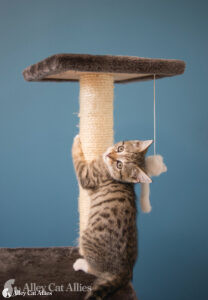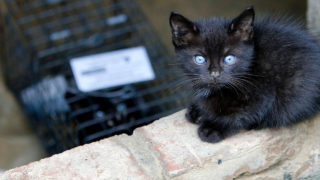Cat Behavior: Scratching
Scratching is a normal, natural, and necessary behavior for cats. You cannot and should not stop a cat from scratching altogether, but you can help cats fulfill their natural need to scratch (and not do damage to the furniture) by redirecting their behavior.
Most cats have five claws on each front foot, and four on each back foot. Polydactyl cats have more toes, which means more nails! Claws are critical to a cat’s anatomy, allowing a cat to climb, hunt, and defend themselves. Cats scratch to remove dead nail sheathes, stretch and strengthen their muscles, and communicate to other cats by marking territory.
When cats scratch, they are not trying to make you mad or be destructive. They have no vendetta against your couch. They’re simply fulfilling a natural and necessary instinct. However, there are ways to redirect cats’ scratching behaviors that will work for you, your cat, and your home.
As you’re working to redirect scratching behaviors, be patient and try a variety of approaches. Sharing your home with a cat means respecting who they are and what they need as a member of the family. You’ll find something that will work!
6 Ways to Redirect Cat Scratching
1. Scratching posts/furniture
Provide cats with scratching posts and other items meant for cats to scratch around your home. Be sure to place scratching posts where cats are already scratching, like in your living room near the couch. You can also put scratching posts where you’d prefer that cats scratch, like in a designated play room. Deck out the scratching posts with an enticing scent, like a catnip spray!
2. Provide a variety of scratching options
Offer different scratching textures like sisal rope, carpet, corrugated cardboard, and natural wood. These textures mimic trees, which is what cats enjoy scratching most of all. Additionally, give cats a variety of scratching surfaces: vertical, horizontal, and slanted. There are scratching posts in all of these shapes!
3. Use humane deterrents
Prevent cats from cats from scratching in certain areas by using humane deterrents like double sided tape or aluminum foil.
Scents like menthol or citrus also work well (cats are NOT big fans!) as do motion detectors that startle cats away from the furniture. When you use deterrents, make sure you have given cats another area they are allowed to scratch. The goal is to redirect the behavior, not try to stop it.
DO NOT utilize any deterrent that does any level of harm to a cat. Do not spray them, hit them, or make any kind of harmful physical content.
4. Trim cat’s claws regularly
Keeping your cats’ claws trimmed may lessen their need to scratch, and will cause less damage when they do scratch. Also, make sure your nail trimmers are sharp so they cut the nail rather than crush it. Replace your trimmers regularly!
5. Offer cats lots of toys
Cats sometimes scratch to relieve excess energy. Toys and plenty of playtime will keep your cats entertained and give them an outlet for their energy, therefore redirecting their scratching instinct.
6. Try nail caps
Nail caps cover cats’ claws in form-fitting plastic. They need to be reapplied as the nails grow, but they come in a variety of colors, so it will be fun to switch it up! If your cat is extremely distressed by the process or the caps themselves, do not continue.
DO NOT declaw your cats
Declawing is far from just a nail trim. It is the surgical amputation of the last joints of a cat’s toes, similar to cutting a person’s finger off at the last knuckle, closest to the fingertip. Declawing is unnecessary, cruel, and can cause long-term harm to cats.
Learn why declawing is needless and inhumane.
If you’re having trouble finding an approach that works, consult a cat behaviorist. They may be able to observe your cat and offer suggestions to redirect their scratching. Learn more about common cat behaviors with our Cat Behavior Webinar Series.

